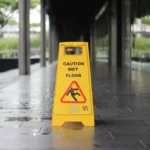
Slip and fall accidents can happen to anyone, anywhere, and at any time. They often result in injuries that can have a significant impact on a person’s life. If you have been involved in a slip and fall accident in California, it’s important to understand the common causes of these accidents and the legal considerations surrounding them. In this blog post, we will explore the causes of slip and fall accidents and provide valuable insights into the legal considerations that apply in California.
Uneven Surfaces and Poor Maintenance
One of the most common causes of slip and fall accidents is uneven surfaces and poor maintenance. This includes cracked sidewalks, potholes, loose flooring or carpeting, and wet or slippery surfaces. Property owners have a legal obligation to maintain their premises in a safe condition and promptly address any hazards.
Hazardous Conditions
Hazardous conditions such as wet or icy walkways, spilled liquids, debris, or loose cables pose a significant risk for slip and fall accidents. Property owners must take reasonable steps to warn visitors of these hazards or promptly address them to prevent accidents.
Inadequate Lighting
Insufficient lighting can contribute to slip and fall accidents, as it hinders visibility and increases the chances of missing potential hazards. Property owners should ensure that all areas are adequately illuminated, especially in stairwells, hallways, parking lots, and outdoor walkways.
Failure to Provide Warning Signs
Property owners are responsible for placing warning signs in areas where hazards exist. Failing to provide appropriate warning signs, such as “Caution: Wet Floor,” can increase the likelihood of slip and fall accidents and may impact liability in a legal claim.
Negligence and Liability
In California, property owners have a legal duty of care to maintain their premises in a reasonably safe condition. When they fail to fulfill this duty and someone is injured as a result, they may be held liable for the damages. However, it’s important to note that comparative negligence applies in California, meaning that the injured party’s own negligence can affect the amount of compensation they may be entitled to receive.
Gathering Evidence
If you are involved in a slip and fall accident, it’s crucial to gather evidence to support your claim. This may include taking photographs of the accident scene, obtaining witness statements, documenting your injuries, and preserving any relevant surveillance footage. Collecting evidence in a timely manner can strengthen your case and help establish liability.
Seeking Legal Representation
Navigating the legal complexities of slip and fall accidents can be challenging, especially when dealing with insurance companies and property owners. Engaging the services of an experienced personal injury attorney is essential. A skilled attorney will assess the circumstances of your accident, gather evidence, negotiate with insurance companies, and advocate for your rights to ensure fair compensation for your injuries and related damages.
Conclusion
Slip and fall accidents can cause severe injuries and have long-lasting consequences. By understanding the common causes of these accidents and the legal considerations specific to California, you can take proactive steps to prevent such incidents. If you are injured in a slip and fall accident, consult with a knowledgeable personal injury attorney to protect your rights and seek appropriate compensation for your injuries, medical expenses, lost wages, and pain and suffering. Remember, prevention and awareness are key to minimizing the risk of slip and fall accidents and ensuring the safety of yourself and others.